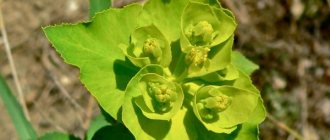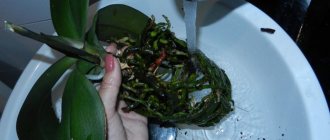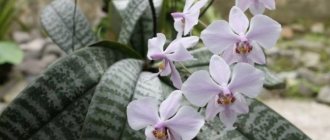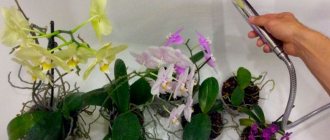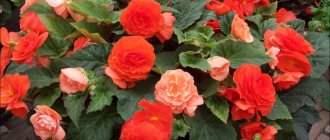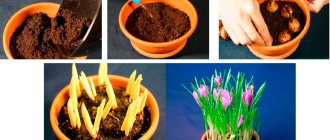The development of a peduncle on an orchid is an important stage for the plant . And sometimes a gardener can wait a long time for its appearance, but from the moment the buds of a tropical plant open, all the care it takes pays off with interest.
But if the care is not organized correctly and the basic rules are not followed,
you may not get a flower arrow .
Therefore, if it is absent for a long period, you need to review the rules of care and find the mistake in order to correct it and give the flower everything it needs. Let's find out in more detail below how an orchid develops a peduncle.
What does it look like?
The arrow looks like a long stem (in favorable conditions it can reach a length of 80 - 100 cm) of green color, cone-shaped, without flowers, which most often grows above the place of previous flowering. The arrow is not smooth, but has irregularities - places where plant buds form: dormant and flowering. From the flowers, buds and orchid flowers are formed, and from the dormant ones, a side arrow or a baby may appear.
The peduncle does not always grow upward; sometimes it can grow to the side or down. It can also bend in a weird way, for example, in the shape of a pig's tail.
Features of the structure of an orchid
For decorative purposes, orchids are mainly bred - epiphytes, that is, those that develop resting on other plants, rock formations or stands. At home, the role of such a stand is performed by pots or special boards, or pieces of bark filled with substrate.
In nature, the role of a support in tropical forests can be performed by any tree in whose bark the orchid is attached and along which it rises towards the sun. But considering this plant a parasite is a mistake. It does not draw any juices from the plant on which it grows, but feeds only on the substrate formed in cracks in the bark, creating hanging roots with which it extracts moisture from the air.
The home orchid has the same structure:
- the root system is located both in the pot with the substrate and hangs outward from the pot. These hanging aerial roots also actively participate in photosynthesis, like leaves;
- leaves are formed annually and are located in the lower part of the plant;
- flowers can be either single or in the form of a whole cluster, it depends on the variety, the petals border the central lip, which plays the role of a pollen accumulator;
- the flowers are located on a peduncle - a special shoot that grows annually from the axil between the leaves; after flowering ends, it dries out and falls off.
Peduncles, like aerial roots, give this crop a unique appearance, which distinguishes the orchid from other flowering indoor plants.
Photo
Next you can see the photos showing the arrow of the orchid:
How is it different from other parts of the plant?
Often, novice flower growers cannot determine what the orchid has produced: a root or an arrow . Indeed, only a florist with many years of experience can accurately identify the part of a plant, especially at first. But after some time, when the process reaches 1 cm in length, this will not be difficult to do.
The main difference is that the tip of the peduncle is sharp and the same color as the shoot, and the root is rounded and pinkish in color. Another part of the plant, which is also often confused with the arrow, can be distinguished by its shape - the root shoot. It has the shape of a boat.
Immediately after its appearance, the root begins to look down (stretches towards the soil and nutrients in it), and the arrow begins to look up (stretches towards the light), just like the root baby. The root is smooth, and the arrow contains "scales". The root most often grows from the neck of the plant trunk, the shoot - between the leaf plates.
We invite you to watch a video on how to distinguish the peduncle from other parts of the orchid:
Should I cut it?
Over the course of several years, flower-bearing arrows may produce flowers more than once. Other individuals fade and dry out, giving way to new shoots. There is no need to rush to immediately remove a peduncle that has lost its decorative effect, despite its unpresentable appearance. While maintaining the green tone, the flower stem is not touched.
Signs will tell you whether it’s time to remove the shoot:
- rapid yellowing of the green peduncle or its acquisition of brown, red, purple colors;
- complete drying of the arrow;
- the green flower-bearing arrow does not produce buds for 6 months.
The flowering shoot needs to be cut off, leaving a 3 cm shoot that comes out of the leaf axil. For cutting use:
- scissors;
- pruning shears;
- with a sharp knife.
The preferred tool is a pruner, which causes minimal harm to the orchid. It is forbidden to pull out dried flower shoots.
How to secure
To get an even stem, carry out the following manipulations:
- The flower is tied vertically when it reaches 20 cm in height.
- The arrow needs to be secured to a support. You will need an elastic band or a special clothespin.
- They correct the situation by turning the flowerpot over. The flowering shoot reaches for the sunlight and straightens itself.
How to get an even peduncle
Having made sure that it is the flowering stem that is developing, it must be tied up in a vertical position in order to grow an even and tall peduncle. The recommendations will help make the shoot straight, tall, and prevent the branch from breaking.
Instructions for the orchid to give an even arrow:
- in a container with phalaenopsis, a support is installed for the growing peduncle;
- a strengthened and grown arrow 16-18 cm long is fixed vertically to a support, using a special clothespin for flowers;
- if the stem deviates to the side and it is not tied, then it is necessary to turn the pot with a flower branch towards the light, it will gradually level out.
Unfortunately, the release of a flower stalk by an orchid does not always mean that it will soon bloom. For this to happen, you need to fulfill all the basic requirements for the care and maintenance of the flower. And if this does not happen, you should not be upset, you just need to take into account all the nuances discussed in the article and wait for the next period of orchid flowering.
Role in the life of a plant
The arrow of an orchid performs a reproductive function. It most often produces babies - small copies of the orchid itself. After they produce a couple of leaves and 3-4 roots, they can be rooted.
In addition, the peduncle is involved in the appearance and development of flowers and buds , nourishes them with water and nutrients, thereby continuing to perform a reproductive function. Each orchid flower contains a seed capsule in which the seeds ripen after pollination by insects. An orchid can also be grown from seeds, but this can happen either in a natural environment - the tropics, or in laboratories, since this process is long and intricate.
How did the flower shoot?
After the period of active growth of roots and leaves, the orchid enters a resting phase, during which the plant shoots out an arrow. Most often this period occurs in autumn, but in good conditions the orchid can bloom several times a year.
An orchid shoot is released from the axil of a leaf , usually the lowest one. The leaf axil is the place where the orchid leaf comes into contact with its trunk. The arrow breaks through the sheet and tends upward. The appearance of the arrow occurs under the influence of many factors: lighting, temperature, watering. If favorable conditions are not created for the orchid, then the formation and release of a peduncle will be impossible.
Height
How quickly does it increase in size?
Growth depends on the following factors:
- From the view. The growth of the flower arrow in a regular phalaenopsis takes about 2 months, and in a hybrid it increases by 30 days. This is the time from the appearance of the embryo to the adult stem with buds.
- From the conditions of detention. They must correspond to the indicators indicated above.
- On the number of flower stalks on the plant. If he is alone, then development proceeds faster than when there are several of them and he looks stronger and healthier.
- From its location. The lateral process goes through the growth phase faster (about 2 weeks earlier).
How many flower shoots are there usually?
A young plant usually shoots one arrow. A more mature flower, which has 6-8 leaves, is capable of developing two, rarely three peduncles.
A pair of flowering stems grown in our latitudes is a very good result. An excessive desire to force the plant to bloom more abundantly leads to its depletion and recovery time, which will require more time in the future.
What to do during this process?
- Place the container with the flower in a well-lit place. Windows facing south, southeast and southwest are suitable for this.
- If daylight hours last less than 12 hours, then the orchid must be placed under an additional light source (fluorescent lamp, phytolamp).
- Provide systematic moderate watering with settled or boiled water at room temperature.
- Continue to feed the plant if this was done before the arrow was released.
As a top dressing, ready-made mineral fertilizers for orchids containing phosphorus and potassium are usually used. They are sold in specialized stores. If fertilizing has not been done before, then you should not start with the release of the arrow - the orchid may “freeze”.
We invite you to watch a video containing recommendations for caring for orchids that have released a peduncle:
The necessary conditions
Light
During the formation of the peduncle, the brightest place is chosen. Since the awakening of meristems usually occurs in autumn, depending on the region of growth, attention should be paid to the power of sunlight.
In more northern regions, during this period the sun is not so scorching and it is possible to place orchids even on a southern window. If the sunlight is still powerful, then it is necessary to place the orhu so that it is diffused. But you should not place it on the north side.
Orchids need to be shaded from direct sunlight.
Before the bulk of the flowers appear, the location cannot be changed , otherwise the formation of buds will be delayed due to the resulting stress. The amount of daylight during this period should not be less than 12 hours. If there is a lack of light, you should use additional lighting using a phytolamp.
Watering
Watering should continue as usual - be moderate. Depending on the growing conditions, the regularity of watering is carried out differently. This could be once every one, two or even four weeks. The state of the substrate should serve as a guide . After watering, it should dry completely.
Fertilizers
Those fertilizers that were applied before the flowering arrow appeared continue to be applied in combination with watering. The supply of nutrition stops with the appearance of the first flower.
The fertilizers that were applied before and during the formation of the arrow determined the number of flowers on it. Excess can significantly shorten flowering time.
Therefore, adding additional nutrition is important before, and not during flowering .
What to do if you can't escape?
- Arrange a temperature difference . The difference between the thermometer readings at night and during the day should be 5C – 7C. A similar difference can be achieved by placing the orchid pot on a heated balcony or terrace.
- Provide enough light for the plant. The required daylight hours are 10–12 hours. In the cold season (autumn, winter), the flower must be illuminated with a phytolamp.
- Ensure proper watering . The orchid requires moderate, systematic watering before flowering and when the arrow appears. But it is important to remember the main principle: do not flood the roots! It is necessary to constantly monitor the condition of the root system and substrate.
Monitor the humidity level in the room where the orchid is located. To release the arrow, the optimal humidity should be 30% - 40%.- Provide the plant with fertilizers based on potassium and phosphorus: they have a beneficial effect on the formation of flower buds.
- Scare . If the above points have been completed, but the orchid has not released an arrow, then it is recommended to arrange a stressful situation for it: reduce watering to a minimum and move the pot to a cooler place.
Some florists use special chemicals to stimulate orchids to bloom. "Epin" is very popular. They should spray the plant daily in the morning.
You can also water the plant by adding 3 to 5 drops of the drug to the water (details in the instructions).
Cytokinin paste is used as a phytoharmone, and succinic acid is used as a growth regulator and anti-stress drug (dissolve 2 g in 1 liter of water).
We suggest watching a video about why an orchid does not produce a peduncle and what to do in this case:
The new arrow broke
- Do not leave a broken arrow on the plant, do not glue it with tape, adhesive tape, or bandage it.
- Cut with sharp and sterile scissors 1–2 cm above the dormant bud. There is a high probability that a lateral peduncle will form from the dormant bud.
- If the peduncle breaks at the root, then you need to cut it off completely, trying to leave a small stump 1-2 cm high.
- Sprinkle the cut area with cinnamon or crushed activated carbon.
- A broken arrow can be placed in water, changing it periodically. An orchid can begin to bloom this way.
To prevent such cases from reoccurring, it is necessary to provide the plant with a habitat in which the likelihood of causing mechanical damage to the flower will be reduced to zero. Since plastic pots are quite unstable, it is advisable to place them in pots that are more stable: glass or ceramic.
Possible problems
It often happens that the arrow is released, but does not develop further, but seems to freeze in place. Or another option is possible: the peduncle has grown, but has begun to dry out. The reasons for such phenomena are directly related to the fulfillment of the basic requirements for the maintenance of an orchid.
Among them:
- improper lighting;
- excess or lack of fertilizers;
- problems with the root system;
- over- or under-watering;
- infectious diseases and pests;
- incorrect temperature.
Pests and diseases
A sick plant is not able to form an arrow. Among the main diseases affecting the peduncle are:
- Powdery mildew. The drug Skor or a solution of colloidal sulfur is used as treatment.
- Gray rot. A fungicide will help in the fight against it.
- Anthracnose. The disease is treated with the drugs Ritomil and Mikasan.
Pests can also cause the lack of arrows. Common harmful insects are:
- Mealybug. The affected plant is treated with a soap solution.
- Shield. Actellik solution is used for treatment.
- Thrips. These insects are destroyed using the drug Fitoverm.
How to care?
In order for an orchid to send out its arrow and enjoy its flowering for a long time, you need to provide it with comfortable living conditions. To do this you should:
- Maintain the room temperature in summer: +22-25ºС, in winter +16-18ºС.
- Place the pot in the sun, but not under scorching rays. In summer, it is recommended to shade the window.
- Maintain humidity during the growing season within 50-60% with a household humidifier, and for releasing a peduncle - 30% - 40%.
- Ventilate the room regularly.
- Water once a week; in between, the soil should dry out completely. To release the peduncle, the “dry” period can be extended.
- Use warm and purified water.
- Fertilize orchids with fertilizers containing potassium and phosphorus.
From our other publications you will learn what role the pseudobulb plays in the life of a plant, what a growing point is and why the roots of a plant grow upward.
The moment the orchid's arrow appears, real joy comes to the gardener. But it is important to remember that the key to the future successful flowering of a plant is compliance with the basic requirements for the conditions of keeping the epiphyte, especially at the moment when the plant is most vulnerable.
